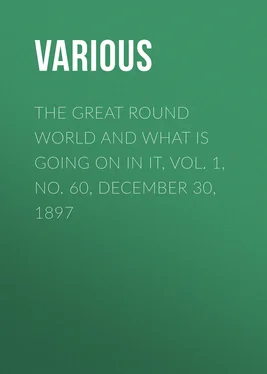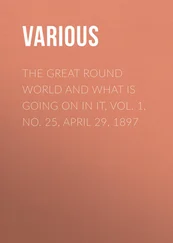Various - The Great Round World and What Is Going On In It, Vol. 1, No. 60, December 30, 1897
Здесь есть возможность читать онлайн «Various - The Great Round World and What Is Going On In It, Vol. 1, No. 60, December 30, 1897» — ознакомительный отрывок электронной книги совершенно бесплатно, а после прочтения отрывка купить полную версию. В некоторых случаях можно слушать аудио, скачать через торрент в формате fb2 и присутствует краткое содержание. Жанр: foreign_children, periodic, foreign_antique, foreign_prose, на английском языке. Описание произведения, (предисловие) а так же отзывы посетителей доступны на портале библиотеки ЛибКат.
- Название:The Great Round World and What Is Going On In It, Vol. 1, No. 60, December 30, 1897
- Автор:
- Жанр:
- Год:неизвестен
- ISBN:нет данных
- Рейтинг книги:5 / 5. Голосов: 1
-
Избранное:Добавить в избранное
- Отзывы:
-
Ваша оценка:
- 100
- 1
- 2
- 3
- 4
- 5
The Great Round World and What Is Going On In It, Vol. 1, No. 60, December 30, 1897: краткое содержание, описание и аннотация
Предлагаем к чтению аннотацию, описание, краткое содержание или предисловие (зависит от того, что написал сам автор книги «The Great Round World and What Is Going On In It, Vol. 1, No. 60, December 30, 1897»). Если вы не нашли необходимую информацию о книге — напишите в комментариях, мы постараемся отыскать её.
The Great Round World and What Is Going On In It, Vol. 1, No. 60, December 30, 1897 — читать онлайн ознакомительный отрывок
Ниже представлен текст книги, разбитый по страницам. Система сохранения места последней прочитанной страницы, позволяет с удобством читать онлайн бесплатно книгу «The Great Round World and What Is Going On In It, Vol. 1, No. 60, December 30, 1897», без необходимости каждый раз заново искать на чём Вы остановились. Поставьте закладку, и сможете в любой момент перейти на страницу, на которой закончили чтение.
Интервал:
Закладка:
Various
The Great Round World and What Is Going On In It, Vol. 1, No. 60, December 30, 1897 / A Weekly Magazine for Boys and Girls
The heavens are affording us an interesting study just now.
Our kind old friend, the sun, it is who is giving us this benefit.
One of the largest sun-spots which has ever been observed is now to be seen.
So large is this spot that it is not necessary to look through a telescope to see it. By using a smoked glass, to dim the intense light of the sun, any one can look at the spot for himself.
Nowadays, when all persons connected with the daily papers are on the lookout for some startling fact that shall sell their newspapers, such an occurrence as the enormous increase in the size of a sun-spot is too good to be let slip by them.
Extra editions about the sun-spot were issued by some of the most enterprising journals, which contained sensational pictures, and statements that the sun-spot was in fact a new world which was about to burst forth from the body of the sun. According to these accounts, the new world was to be sent whirling through space, hurled, as it were, at our earth, which was to be shattered to pieces by it.
Except that such stories serve to call the attention of unscientific people to scientific facts, and teach them to observe the wonders of the universe, it really seems a shame that such marvels should be used as bogies to scare the ignorant and superstitious.
As a matter of fact, very little is known about these sun-spots. They occur in greatest numbers in periods of about eleven years apart, and astronomers and geologists agree that periods of rainy and dry seasons seem to correspond with the sun-spot periods.
When the greatest number of spots are visible on the sun, scientists agree that the climatic conditions on the earth are normal and even. When there are fewest spots on the sun we have extreme temperature and sudden changes. When we say that astronomers and geologists agree on this point, we must also admit that some astronomers are not quite satisfied that the fact has been proved.
The only fact that has been actually proved to everybody's satisfaction is that, during the time when the most spots are visible on the sun, there are always more magnetic storms and displays of the aurora borealis.
A magnetic storm is a disturbance of the magnetic field which surrounds the earth; its presence is shown by a disturbance of the needle of the compass, and it often interferes with the electrical currents, making it difficult and sometimes impossible to use the telegraph-wires.
The aurora borealis is a wonderful light seen in the sky in high latitudes, and less frequently in other parts of the world—except during the activity of the sun-spots.
It appears as irregular patches and dancing columns of light which flame across the sky. Red, white, pale green—these shafts are now dim, now bright, seeming to throb and pulse as they glow and pale. As you watch them they change their form, and, from being pillars of fire, change to masses of glowing color.
A flash-light dancing across the sky gives you some, though a very poor notion, of an aurora. The aurora has thousands of such flashes of light, changing form and color as you watch them—filmy shafts of light, coming you know not whence.
The spots on the sun are described as being dark patches which are visible on the bright surface of the sun. They often appear in groups, and frequently the larger spots will break up into smaller ones. They are great depressions or holes in the surface of the sun, and are supposed to be formed by descending currents of gases.
Sun-spots are generally found in the neighborhood of the sun's equator, and last from a few hours to a few months.
The presence of these spots has enabled scientists to prove that the sun, like the earth, revolves on its axis.
The last period of activity for sun-spots was in 1893, and, according to the eleven-year theory, there should be few, if any, at this time. Prof. Garret P. Serviss, however, tells us that at times during the quiet period of the sun, large spots like the present one will appear on its surface, and after assuming immense proportions, vanish.
The present phenomenon appears to be about one hundred thousand miles in length, and some people insist that they can see it gradually detaching itself from the sun and forming itself into a new world.
This is regarded as a hoax by scientific men who understand such matters.
It is hard to prove exactly whether the present great sun-spot is a large hole in the surface of the sun, or a large mass of the body of the sun which is about to be detached from it; but in all such matters it is wiser to take the most practical and least sensational view. Similar phenomena to that which is now interesting us have been observed before, and so, until we have proof to the contrary, it is more sensible to believe it is a sun-spot than to listen to sensational tales of a new world running wild through space.
Sun-spots were first observed about 1610 by Galileo, so they have been known long enough for us to believe that they are not new worlds about to be flung into space.
Galileo was the great Italian astronomer who invented the telescope.
The chances are that the present sun-spot may give us an opportunity of seeing a fine aurora. In 1892, when the last large spot was visible, there was a notable aurora. The light rays reached so far south that to the people in New York it appeared like the reflection on the sky from a great fire.
Francis Kossuth's effort to get the Austro-Hungarian bill delayed has not been successful.
You remember he tried to get the bill referred to a certain committee.
His motion was defeated by a large majority.
This looks rather promising for the bill which Baron Banffy is trying to get through the House, and which, you remember, is to prolong the contract between the two nations for another year; at the same time, the best friends of the measure are doubtful if it will be possible to pass it.
The mass of the Hungarian people are in sympathy with Kossuth, and would be glad if Hungary could regain her freedom. It is therefore supposed that when the bill comes up for a final hearing, Kossuth will use all his fiery eloquence to dissuade the people from passing it, and that it will be defeated.
Persons who are able to look at both sides of the question are of opinion that separation would be a great misfortune for both countries. Austro-Hungary is now a great and powerful kingdom, holding a position in Europe which enables her to preserve the balance of peace in the eastern portion of that troubled continent.
With Austria and Hungary divided into two small kingdoms with separate aims and interests, Turkey could not be held in check any longer, and the Russians, who are so full of ambition for power in the East, could do pretty much as they pleased.
The Hungarians are supposed to be a very wide-awake people, and able to comprehend the true meaning of a political situation. It is therefore supposed that in the present crisis they are not striving so much for freedom, which would be a disadvantage to them, as for the supremacy in the two kingdoms.
This idea is outlined by Kossuth in a speech made by him the other day, in which he said: "We want a separate army and separate treasury. The King of Hungary should be Emperor of Austria as a sort of extra occupation. Vienna (the capital of Austria) is already a suburb of Budapest (the capital of Hungary), and in time Austria will become a collection of provinces attached to Hungary."
Rioting still continues in Prague. The troops are patrolling the street, and special guards have been stationed at the places where outbreaks are feared.
Читать дальшеИнтервал:
Закладка:
Похожие книги на «The Great Round World and What Is Going On In It, Vol. 1, No. 60, December 30, 1897»
Представляем Вашему вниманию похожие книги на «The Great Round World and What Is Going On In It, Vol. 1, No. 60, December 30, 1897» списком для выбора. Мы отобрали схожую по названию и смыслу литературу в надежде предоставить читателям больше вариантов отыскать новые, интересные, ещё непрочитанные произведения.
Обсуждение, отзывы о книге «The Great Round World and What Is Going On In It, Vol. 1, No. 60, December 30, 1897» и просто собственные мнения читателей. Оставьте ваши комментарии, напишите, что Вы думаете о произведении, его смысле или главных героях. Укажите что конкретно понравилось, а что нет, и почему Вы так считаете.












